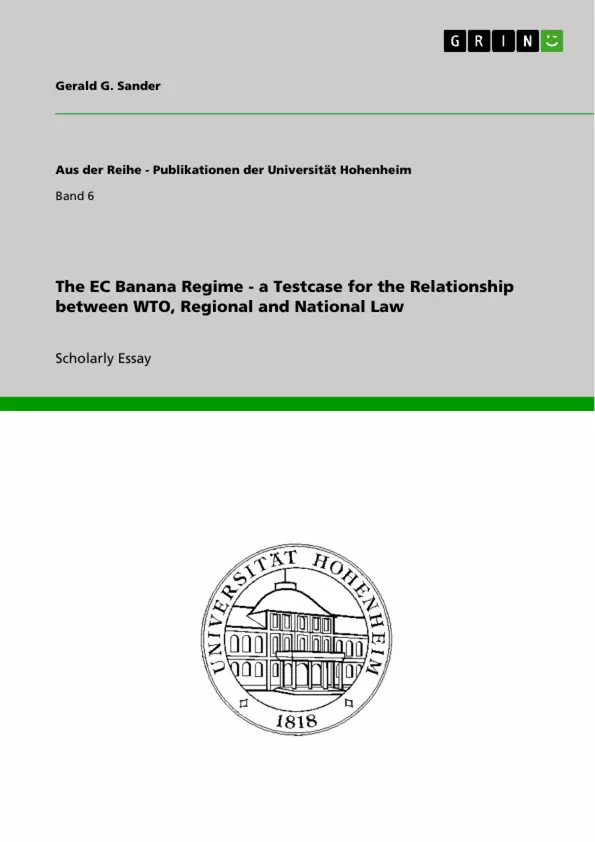The creation of the internal market within the European Community (EC) made it
necessary to integrate the differing national arrangements that were still existing by
1993 with regard to a variety of goods. One of these Community-wide regimes adopted
is the EC banana regime. It is one of the most disputed regimes so far1
An import tax of 20 was in force in the open, free market economies of the
Benelux, Ireland and Denmark before the EC banana regime came into force. Only in
Germany was no import tax levied because of the Banana Protocol of 25 March 1957.
Bananas from ACP countries could be imported into all EC countries as a matter of
principal tax free pursuant to Art. 168 of the Lomé Convention IV. After 5 years of negotiation2 the common market organization for bananas came
into force on 1 July 1993. The legal basis is the Council Regulation (EEC) 404/933, a
brief summary of which follows. Its regime discriminates against banana producers who
are not based in the EC or in countries of the African, Caribbean or Pacific area (ACP),
and against companies that distribute bananas that originate in those countries. At
present imports of bananas from twelve previously determined traditional ACP
countries enter the Community duty free, up to a maximum quantity fixed for each
country in the regulation. Non-traditional ACP and third-country imports are subject to
a tariff quota which lies well below the quantity these countries exported to the EC
before the new banana regime was introduced with an import tax of 100 ECU per tonne.
Furthermore, out of quota shipments are subject to a prohibitive duty, which renders
importation uneconomical, that is 750 ECU per tonne for imports from ACP states and
850 ECU per tonne for third country bananas. Licensing requirements are applied to
imports of traditional as well as non-traditional ACP- and third countries. As a result of
these regulations, operators who traditionally marketed third country bananas have a
competitive disadvantage over those who marketed Community bananas.4 Licenses for
importation of bananas from non-traditional ACP and third countries are issued to three
market sharing groups. Accordingly the earlier importers of these bananas only receive
a quota of 66.5%.
[...]
Inhaltsverzeichnis (Table of Contents)
- I. The EC common market organization for bananas
- II. WTO Panels relating to the EC banana regime
- III. Judgment of the European Court of Justice
- 1. Germany v. Council [Bananas]
- 2. Criticism of this judgment
- V. Conclusion
Zielsetzung und Themenschwerpunkte (Objectives and Key Themes)
The primary objective of this work is to analyze the legal complexities surrounding the EC banana regime, specifically examining the relationship between WTO law, regional EC law, and national law. The focus is on how the banana regime, with its discriminatory aspects, navigates the interplay of these legal frameworks and the resulting legal challenges it presents.
- The EC banana regime's discriminatory nature and its impact on banana producers and importers
- The role of WTO panels in addressing the regime's incompatibility with international trade law
- The European Court of Justice's controversial judgment on the relationship between WTO and EC law in the context of the banana regime
- The legal and political implications of the EC banana regime for both the European Community and member states
Zusammenfassung der Kapitel (Chapter Summaries)
Chapter I details the establishment of the EC banana regime as a response to the need for harmonizing national regulations within the internal market. It outlines the regime's discriminatory features, including tariff quotas and licensing requirements, which favor banana producers from ACP countries over third-country producers.
Chapter II focuses on the WTO panels that have addressed the legality of the EC banana regime. It highlights how multiple panels, including the 1994 and 1997 panels, found the regime to violate GATT provisions. This chapter also delves into the Framework Agreement on Banana Imports, which attempted to address the concerns raised by the panels but ultimately failed to eliminate the regime's discriminatory nature.
Chapter III examines the European Court of Justice's landmark ruling in the case of Germany v. Council [Bananas]. This chapter analyzes the court's decision to reject Germany's claim that the banana regime violated both Community law and GATT law. The focus is on the court's reasoning for denying the direct effect of GATT provisions within the Community legal order.
Chapter V presents the author's conclusions, which are excluded from this preview to avoid spoilers.
Schlüsselwörter (Keywords)
The work centers around the EC banana regime and its implications for international trade law. Key terms and concepts include WTO law, GATT 1994, European Community law, dispute settlement mechanisms, direct effect of international agreements, discriminatory trade practices, tariff quotas, licensing requirements, and the relationship between regional and national law.
- Quote paper
- Dr. Gerald G. Sander (Author), 1998, The EC Banana Regime - a Testcase for the Relationship between WTO, Regional and National Law, Munich, GRIN Verlag, https://www.grin.com/document/7266



